A vapor barrier is designed to prevent moisture from passing through walls, floors, and ceilings, reducing the risk of mold and structural damage. An air barrier controls the movement of air within a building envelope, improving energy efficiency by minimizing drafts and heat loss. Proper integration of both barriers is crucial for maintaining indoor air quality and building durability.
Table of Comparison
| Feature | Vapor Barrier | Air Barrier |
|---|---|---|
| Purpose | Blocks moisture vapor diffusion | Prevents air leakage and drafts |
| Material Examples | Polyethylene sheets, foil-faced kraft paper | Spray foam, house wraps, rigid foam panels |
| Installation Location | Inside wall or ceiling assemblies, warm side of insulation | Continuous layer on building exterior or interior |
| Primary Function | Control moisture to prevent condensation | Maintain building envelope airtightness for energy efficiency |
| Impact on Indoor Air Quality | Indirect by controlling moisture | Direct by reducing air infiltration |
| Code Requirements | Required in cold climates per IRC and IBC | Required by energy codes (IECC, ASHRAE 90.1) |
| Common Installation Issues | Improper placement causing trapped moisture | Gaps or tears compromising airtightness |
What Is a Vapor Barrier?
A vapor barrier is a material designed to prevent moisture diffusion through walls, ceilings, and floors, protecting building components from water damage and mold growth. It typically consists of polyethylene sheets or foil-faced insulation installed on the warm side of the insulation to maintain indoor air quality and structural integrity. Proper vapor barrier installation is crucial in controlling condensation and ensuring energy efficiency in building envelopes.
What Is an Air Barrier?
An air barrier is a material or system designed to control the movement of air through building assemblies, reducing energy loss and improving indoor air quality. It helps prevent drafts, moisture intrusion, and thermal bridging by sealing gaps, cracks, and joints in walls, roofs, and floors. Unlike vapor barriers, which primarily limit moisture diffusion, air barriers focus on stopping air leakage to enhance building envelope performance.
Key Differences Between Vapor Barriers and Air Barriers
Vapor barriers primarily control moisture diffusion by limiting water vapor transmission through building assemblies, while air barriers restrict the uncontrolled flow of air that can carry moisture and contaminants. Vapor barriers are typically made of materials with low permeance like polyethylene sheeting, whereas air barriers consist of materials or assemblies designed to create continuous seals such as sprayed polyurethane foam or specialized membranes. Understanding the distinct roles and installation requirements of vapor barriers versus air barriers is crucial for effective moisture management and energy efficiency in building envelopes.
Functions and Roles in Building Construction
Vapor barriers primarily prevent moisture diffusion through walls, floors, and ceilings, protecting building materials from condensation and mold growth. Air barriers control airflow by sealing gaps and cracks, improving energy efficiency and indoor air quality through reduced air leakage. Understanding the distinct roles of vapor and air barriers ensures optimal thermal performance and durability in building construction.
Materials Commonly Used for Vapor and Air Barriers
Polyethylene sheets, foil-faced kraft paper, and asphalt-coated kraft paper are commonly used materials for vapor barriers designed to prevent moisture migration in building envelopes. Air barriers typically utilize materials such as house wraps, self-adhered membranes, spray foam, and rigid foam boards to control air leakage and improve energy efficiency. Selecting the appropriate material depends on factors like climate, building design, and installation requirements for optimal performance.
Where to Install Vapor Barriers vs Air Barriers
Vapor barriers are typically installed on the warm-in-winter side of insulation to prevent moisture from condensing within wall cavities, commonly found in colder climates. Air barriers are placed continuously across the building envelope, including walls, roofs, and foundations, to control air leakage and improve energy efficiency. Proper placement of vapor and air barriers is critical to avoid moisture damage and maintain indoor air quality, with vapor barriers focusing on moisture control and air barriers emphasizing airtightness.
Impact on Energy Efficiency and Moisture Control
Vapor barriers reduce moisture diffusion through building assemblies, preventing condensation and mold growth that compromise insulation performance and indoor air quality. Air barriers control air leakage, significantly lowering heat loss and gain, which enhances overall energy efficiency by maintaining consistent indoor temperatures. Proper integration of both barriers ensures optimal moisture management and thermal performance in building envelopes, reducing energy costs and improving durability.
Common Installation Mistakes and Solutions
Common installation mistakes of vapor barriers include improper sealing at seams and failure to overlap sheets adequately, leading to moisture infiltration and mold growth. Air barriers often suffer from gaps around penetrations and poor adhesion to substrates, compromising energy efficiency and indoor air quality. Solutions involve meticulous sealing with compatible tapes, ensuring continuous coverage, and using integrated systems designed for both vapor and air barrier functions.
Codes and Standards for Vapor and Air Barriers
Building codes such as the International Residential Code (IRC) and standards like ASTM E2178 specify requirements for both vapor barriers and air barriers to ensure moisture control and energy efficiency in construction. Vapor barriers are primarily addressed by ASTM E1745, which sets guidelines for permeance and installation to prevent moisture transmission in walls and ceilings. Air barriers must comply with air leakage limits defined by testing standards like ASTM E779 and be integrated according to ASHRAE standards to maintain indoor air quality and structural durability.
Choosing the Right Barrier for Your Building Project
Selecting the appropriate barrier for your building project depends on understanding the distinct functions of vapor barriers and air barriers. Vapor barriers control moisture diffusion to prevent condensation and mold growth, essential in areas with high humidity or temperature differentials. Air barriers block uncontrolled airflow, enhancing energy efficiency and indoor air quality by reducing drafts and infiltration.
Vapor Barrier vs Air Barrier Infographic

 productdif.com
productdif.com